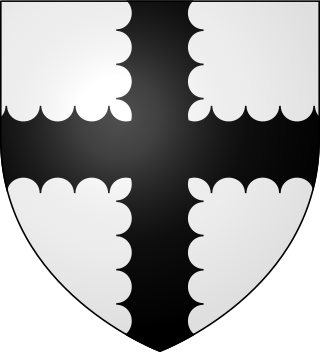Loading AI tools
From Wikipedia, the free encyclopedia
Baron of Roslin or Rosslyn was a Scottish feudal barony held by the St Clair or Sinclair family.


No certain record exists but it is likely that the Sinclairs came from Saint-Clair-sur-Epte in Normandy.[1] According to traditional history, William of Saint-Claire accompanied Saint Margaret of Scotland, daughter of Edward the Exile to Scotland in 1068, where she eventually married Malcolm III of Scotland. In return for his efforts, the king supposedly granted Sinclair the barony of Roslin "in free heritage".[2] However, according to late 19th century historian Roland Saint-Clair, it is not known if the people who held the estate of Roslin before William St. Clair (died 1297), who is by tradition the 6th Baron, were actually of the same surname, and that he arrived in Scotland from Normandy in the 13th century.[3] William Sinclair (died 1480) who was the 11th Baron of Roslin was also the 3rd Earl of Orkney, 1st Earl of Caithness and 2nd Lord Sinclair. He divided his estates: his eldest son from his first marriage, William, inherited the title of Lord Sinclair, while he left the Barony of Roslin to his eldest son from his second marriage, Oliver, and the earldom of Caithness to his second son from his second marriage, another William, from whom descend the chiefs of the Clan Sinclair.[4] The family of Roslin or Rosslyn prefer the spelling "St Clair" whilst the family of Caithness prefer the spelling "Sinclair".
Although the Rosslyn Chapel tourist website refers to the early Barons by the spelling of Rosslyn,[5] most historic sources refer to them by the spelling of Roslin which is also used for the castle.[6][7] The later Earls consistently appear with spelling of Rosslyn in accordance with the name of the chapel. The Rosslyn Chapel tourist website also refers to several of the early Barons as Princes of Orkney,[5] whereas most of the historic sources refer to them as Earls of Orkney.[8][9][7]
It is not known if the Sinclairs or St Clairs of Roslin share a common origin with the Sinclairs or St Clairs who held the title of Lord Herdmanston.[10] Herdmanston in East Lothian had been held from the 12th century, when Henry St Clair received a grant of the lands of Herdmanston, from Richard de Morville, Constable of Scotland.[2] According to the website sinclairgenealogy.info, the fact that the first proven Baron of Roslin, William St. Clair (died 1297) was made sheriff of Haddington in East Lothian where Herdmanston also is, suggests that he was appointed there to cover his own home area, and given that the name William appears frequently in the St Clair of Herdmanston family suggests that he may have been part of their extended family.[11] However, according to the website clansinclairusa.org, William St Clair of Roslin was probably unrelated to the St Clairs of Herdmanston.[12] According to Archibald Allan writing in 1900, Henry St Clair of Herdmanston appears to have been a son of the first William de St Clair of Roslin of the 11th century,[13] but this William's existence cannot be proved by contemporary evidence and according to Roland Saint-Clair, William St. Clair who died in 1297 was the first proven Baron of Roslin.[3]
Seamless Wikipedia browsing. On steroids.
Every time you click a link to Wikipedia, Wiktionary or Wikiquote in your browser's search results, it will show the modern Wikiwand interface.
Wikiwand extension is a five stars, simple, with minimum permission required to keep your browsing private, safe and transparent.